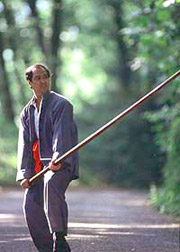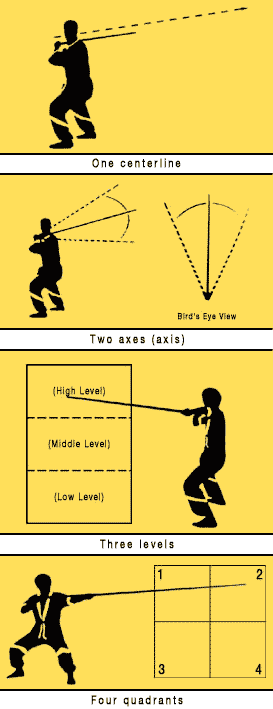|
 |
|
The
WingTsun
Long Pole
and
Its Concepts |
|
The WingTsun long pole is generally 8.5 to 9 feet long, which
equals about 10 Chinese feet in length. It is nicknamed the
"rat-tail pole" because one end, called the tail, is smaller in
diameter than the thicker end, which is called the head. The
pole is typically made of ironwood or teak and worked to have a
smooth surface.
The luk dim boon gwun form is simple, precise, and elegant.
Possessing only 7 key techniques, the sequence of the form is
also rather compact - showing the efficient nature of WingTsun.
Like the empty-hand WingTsun system, the long pole is based on a
number of key theories which - once understood - enable the
practitioner to correct and refine his own movements.
 One of the most popular WingTsun theories - often misconstrued
as relating to fist-fighting techniques - actually applies to
pole-fighting. The so-called "four gates" or "four quadrants"
theory comes from a long pole motto that states, "One
centerline, two axes (axis), three levels, four quadrants". One of the most popular WingTsun theories - often misconstrued
as relating to fist-fighting techniques - actually applies to
pole-fighting. The so-called "four gates" or "four quadrants"
theory comes from a long pole motto that states, "One
centerline, two axes (axis), three levels, four quadrants".
The interpretation
of this motto relies on 3-dimensional geometry.
The "one line" is the pole itself as seen from the bird's eye
view.
The "two axes" refer to a horizontal X-axis and Y-axis that
describe the extremes of the pole's lateral range moving left or
right, as seen from the bird's eye view.
This is also
called sin min gwun (fan surface pole), as the concept resembles
an opened Chinese fan. The third motto is the "three levels"
concept. This represents the Z-axis and is broken down into 3
key levels: high, middle, and low target areas as viewed
horizontally by the person using the long pole.
Lastly, you have the four quadrants theory (often called four
gates), which is the most important in terms of understanding
the key usage of the long pole. There is an ancient Chinese
saying which states, "One person guards the gate and 10,000
intruders cannot go in." In fact, this saying directly relates
to the long pole's original usage. Much like a hermit crab that
defends itself through the small opening of its shell, the pole
man was commonly employed to guard a narrow gate, entrance, or
doorway.
Basic Training for the Long Pole
The WingTsun empty-hand system uses stances and footwork
optimized for weaponless fighting. The basic yee chi kim yeung
mah (character two adduction stance), the sideling stance, and
the advancing (or fighting stance) are all rather narrow and
high.
However, the main pole stance, gwun mah, is much lower and wider
to allow better leverage in manipulating the long weapon. This
low stance, combined with the stepping from the empty-hand
system, provides leverage, stability, and quick steps.
In the beginning, students are taught the gwun mah
(quadrilateral pole stance), in addition to stepping and
punching exercises. Once the student possesses a firm stance, he
will learn simple strength training exercises in which the pole
is raised and lowered. These exercises are required for the
student to have the strength necessary to perform the long pole
form and chi-gwun exercises. With time, a proficient WingTsun
pole expert can maneuver the pole as easily as if it were a
chopstick.

Grandmaster
Leung Ting - Gwun Mah / Biu Lung Cheong
Next, the student will combine the basic footwork and pole
techniques to step and thrust, press down with the pole, raise
the pole, and advance. Students at this stage will practice the
biu lung cheong (thrusting dragon spear), an exercise where the
student will aim, step, and apply a spearing thrust with the
pole at a small target such as a suspended bell. By using
progressively smaller targets and putting them in motion, the
WingTsun practitioner can improve his marksmanship and speed.
Finally, when a student has developed sufficient strength and
exhibits proficiency in the basic stances, footwork and pole
movements, he is ready to learn the Luk Dim Boon Gwun Long Pole
form.
Part from "WingTsun's Devastating Long Pole" by Jeff Webb and
Leung Ting
Source: Kung Fu Magazine
|

 One of the most popular WingTsun theories - often misconstrued
as relating to fist-fighting techniques - actually applies to
pole-fighting. The so-called "four gates" or "four quadrants"
theory comes from a long pole motto that states, "One
centerline, two axes (axis), three levels, four quadrants".
One of the most popular WingTsun theories - often misconstrued
as relating to fist-fighting techniques - actually applies to
pole-fighting. The so-called "four gates" or "four quadrants"
theory comes from a long pole motto that states, "One
centerline, two axes (axis), three levels, four quadrants".
